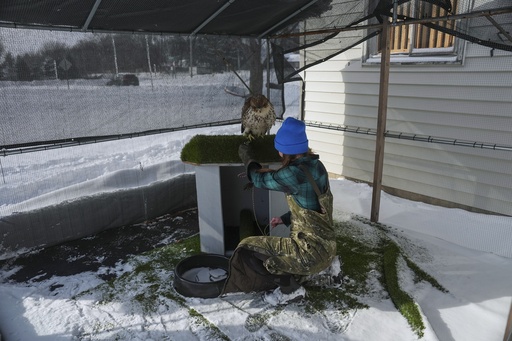GREENLEAF, Wis. — In the icy grip of a Wisconsin winter, Stephanie Stevens finds a unique thrill. Each weekend, she packs her minivan with a large green box and journeys into the rural landscapes, often near friends’ farmland.
Inside the box, an unusual companion waits: Alexie Echo-Hawk, affectionately called Echo, a young red-tailed hawk. Clad in a thick leather glove, Stevens lets Echo hop onto her wrist. “She’s intense,” she remarks, gently stroking Echo’s speckled feathers.
Falconry enthusiasts like Stevens dedicate much of the chilly season to the open air, partnering with their feathered allies to hunt small creatures such as rabbits and grouse. The impact of climate change accompanied by rural development and shifts in agriculture and forestry is evident to many falconers. They see changes reflected in their surroundings, from the snowshoe hares migrating northward to diminishing snow cover and burgeoning suburbs.
These changes compel falconers to adapt—seeking new prey, adjusting their hunting seasons, and confronting the evolving natural world. Falconers find themselves motivated to conserve the territories where they and their birds hunt, experiencing a sense of loss as human-induced factors transform these areas.
“My empathy extends equally to what I’m hunting and the bird perched on my hand,” stated Tom Doolittle, a retired biologist and lifelong falconer in northern Wisconsin. He sees falconry as both “a sport of observation and participation,” which has significantly evolved over time.
In Pursuit of Cottontails
Echo swiftly ascends to tree heights as Stevens and her children navigate the snow below, mainly in search of cottontail rabbits. They aim for dense underbrush or brambles, where Stevens energetically disturbs the brush with a stick or by leaping onto it, hoping to flush out hidden critters.
A rabbit eventually dashes out, with Echo diving after it. Despite the occasional miss, the suspense is palpable. “Even when the hawk doesn’t catch it, it’s always so close,” Stevens’ son Daniel explained. “That moment is electrifying.”
Falconry, an ancient practice, is subject to stringent regulations in North America where it’s neither native nor commonly accessible. Falconers generally capture wild birds who have learned to hunt independently, releasing them back to nature once the season concludes. These birds, capable of independent flight, often return to their human partners who assist in locating prey.
This connection allows falconers to “witness nature in ways not typically experienced,” Stevens shared, fostering a heightened sense of accountability toward environmental preservation.
Hillary Neff, president of the Wisconsin Falconers Association, noted an increased attentiveness to wildlife patterns and weather shifts since embracing falconry. However, she expressed discontent over delays in the falconry season due to unusually warm falls. “With a raptor, you immerse fully in the lifecycle, reliant on nature’s whims,” she emphasized.
Evolving Wildlife Landscapes
Doolittle, stationed in a wooded area about an hour south of Lake Superior, hunts using goshawks—stately gray birds with piercing orange eyes—who naturally prey on snowshoe hares. However, he has witnessed declining numbers of these animals, which turn from brown to white in winter for camouflage.
During a snowless winter, Doolittle encountered a hare fruitlessly attempting to conceal itself against a stark backdrop. “I felt such compassion for him,” he reflected. Snow consistency fluctuates annually, but trends show shorter durations of snow cover due to warmer temperatures, impacting reliant wildlife.
Doolittle’s explorations through anticipated hare habitats too often reveal diminished indicators, contributing to his sense of loss over what represents the northern wilderness.
This observation is supported by Jonathan Pauli, a University of Wisconsin-Madison professor specializing in wildlife ecology. By tracking predators and their prey, Pauli’s team has documented snowshoe hares gradually retreating northward, becoming more visible to predators due to their now-ineffective white coats amidst sparse snow.
Pauli emphasizes efforts should be directed toward strategic conservation of various winter-adapted species amid climate change pressures, though balancing such efforts may affect other wildlife like martens.
Challenges Impacting Falconry
Each hunting expedition carries unique challenges. Less snowfall might grant easier movement but removes natural advantages such as prey visibility. Birds also show reluctance toward hunting in extreme cold. Unpredictable weather events can temporarily skew prey populations, while changes due to human activity, from pesticides to urban sprawl, reshape entire ecosystems.
Doolittle remarks on how human influence often adversely impacts other species. “We must acknowledge ourselves as the dominant transformative force on Earth,” he stated. “Adapting to these changes is difficult, especially when they affect deeply-held ways of life.”




